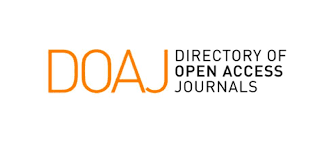Relocation of Earthquakes Hypocenter Using the Double Difference Method in Bali and Its Surrounding Areas
Abstract
A study on the relocation of earthquake hypocenters using the Double Difference method has been conducted in Bali and its surrounding areas. This research was carried out at the Center for Meteorology, Climatology, and Geophysics Region III Denpasar. The purpose of this study is to find out the distribution of earthquake hypocenters before and after the relocation and to know the continuity of earthquake hypocenters in the Bali region. The data used are arrival time data of 1,815 earthquake events from January 1, 2014 to December 31, 2023, and data from 26 earthquake recording stations. The relocation method applied is the Double Difference method, which is processed with ph2dt and HypoDD. The relocation that has been carried out shows a good hypocenter position which is characterized by a residual value of travel time that is close to 0. The distribution of the earthquake hypocenter in the Bali area before the relocation spread throughout the region and after the relocation, the position of the hypocenter was getting closer to the source of the earthquake, namely in the subduction zone under the Bali area as shown in the cross-section results. In addition, based on the results of the analysis of the hypocenter of the earthquake after relocation, it was found that the trend of the hypocenter continued toward the subduction subduction zone.
Downloads
References
[2] T. A. P. Setiadi and S. Rohadi,”Relokasi Gempa Bumi Teleseismic Double-Difference di Wilayah Bali-Nusa Tenggara dengan Model Kecepatan 3D,” Jurnal Lingkungan dan Bencana Geologi, vol. 9 no. 1, pp. 45–52, 2018.
[3] I. N Setiawan, D. Krismawati, S. Pramana, and E. Tanur, “Klasterisasi Wilayah 117 Rentan Bencana Alam Berupa Gerakan Tanah dan Gempa Bumi di Indonesia,” in Seminar 118 National Official Statistics, 2022, pp. 669–676.
[4] N. Nuraeni, M. Mujiburrahman, and R. Hariawan, “Manajemen Mitigasi Bencana pada 123 Satuan Pendidikan Anak Usia Dini untuk Pengurangan Risiko bencana Gempa Bumi dan 124 Tsunami,” Jurnal Penelitian Dan Pengkajian Ilmu Pendidikan: E-Saintika, vol. 4, no. 1, pp. 68–79, 2020.
[5] N.P.J.A.R. Pangastuti, “Analisis Energi Potensial Gempabumipada Zona Subduksi Wilayah Bali,” Buletin Fisika, vol. 33 no. 2, pp. 137–144, 2022.
[6] T.A.P. Setiadi, Y. Daud, A.A. Martha, and S. Rohadi, “Relokasi Gempabumi Menggunakan Metode Teleseismik Double Difference di Wilayah Jawa,” Jurnal Meteorologi dan Geofisika, vol. 23, no. 1, pp. 23–27, 2022.
[7] M.F. Gracynthia, “Relokasi Hiposenter Gempabumi Menggunakan Metode Coupled Velocity-Hypocenter dan Local Earthquake Tomography Untuk Sesar Palu Koro,” Institut Teknologi Sepuluh Nopember, Surabaya, 2015.
[8] A.M. Lubis, “Analisis Kecepatan Gelombang Seismik Bawah Permukaan di Daerah yang Terkena Dampak Gempabumi 4 Juni 2000 (Studi Kasus: Kampus Universitas Bengkulu),” Jurnal Gradien, vol. 1, no. 2, pp. 69–73, 2005.
[9] N. Nakif, Darsono, and K. Sorja, “Penentuan Tingkat Kekerasan Batuan Menggunakan Metode Seismik Refraksi di Jatikuwung Karanganyar,” Indonesian Journal of Aplied Physics, vol. 3, no. 1, pp. 29–35, 2013.
[10] S. Ayub, M. Zuhdi, and J. Rakhmat, “Aplikasi Metode Seismik Refraksi dalam Menentukan Lapisan dan Tingkat Kekerasan Batuan di Bawah Permukaan Desa Medana Lombok Utara,” Kappa Journal, vol. 4, no. 2, pp. 188–196, 2020.
[11] V. Arintalofa, G. Yuliyanto, and U. Harmoko, “Analisa Mikrotremor Menggunakan Metode HVSR untuk Mengetahui Karakteristik Bawah Permukaan Manifestasi Panas Bumi Diwak dan Derekan Berdasarkan Nilai VP,” Jurnal Energi Baru & Terbarukan, vol. 1, no. 2, pp. 54–61, 2020.
[12] K.E. Bullen and A.B. Bruce, An Introduction to The Theory of Seismology, 4th ed. USA: Cambridge University Press, 1965.
[13] A.V.H. Simanjutak and Olyphia, “Perbandingan Energi Gempabumi Utama dan Susulan (Studi Kasus: Gempabumi Subduksi Pulau Sumatera dan Jawa),” Jurnal Fisika FLUX, vol. 14, no. 1, pp. 19–26, 2017.
[14] A.M. Dziewonski and D.L. Anderson, “Preliminary Reference Earth Model,” Physics of the Earth and Planetary Interiors, vol. 25, no. 4, pp. 297–356, 1981.
[15] F. Waldhauser and W.L. Ellsworth, “A Double Difference Earthquake Location Algorithm: Method Application to the Northern Hayward Fault, California,” Bulletin of Seismological Society of America, vol. 90, no. 6, pp. 1353–1368, 2000.
[16] S.J. Hutchings and W.D. Mooney, “The Seismicity of Indonesia and Tectonic Implications,” Menlo Park, CA, USA, Oct. 2021.
[17] S. Hidayatunnisak, A. Susilo, and M. Anshori, “Studi Tomografi Seismik Untuk Menentukan Model Kecepatan Gelombang P daerah Bali,” Universitas Brawijaya, Malang, Indonesia, 2015.
[18] Y.R. Serhalawan, “Petunjuk Teknis Relokasi Hiposenter Gempabumi Menggunakan Program Hypocenter Double Difference (HypoDD) Berdasarkan Data Katalog/ Buletin Gemabumi,” Sorong, Indonesia, 2018.










